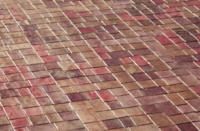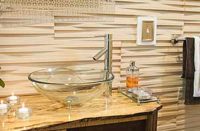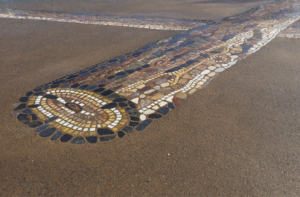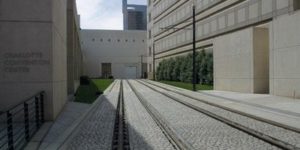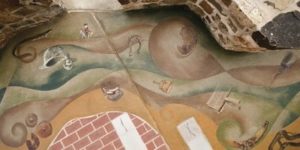
If Florida’s Turnpike were a rail line, the Fort Drum service plaza in the south central part of the state would be the equivalent of New York’s Grand Central Station, with glitzy interior treatments that include terrazzo floors and decorative exterior treatments and landscaping that evoke Florida’s unique natural environs.
So says David Edwards, owner of Edwards Concrete, of Winter Garden, Fla. He considers the Fort Drum service plaza to be the crown jewel of a series of turnpike stops decked out with decorative concrete after a multiyear renovation program directed by Florida’s Turnpike Enterprise. Edwards Concrete played a part in spiffing up the service plazas, with decorative concrete installations that included walkway and plaza areas outside service station and restaurant facilities.
From the north, the first jewel is at Turkey Lake, then comes Canoe Creek, Fort Drum, West Palm Beach, and finally Pompano Beach. These were all major upgrades — reconstructions essentially — of existing facilities that hadn’t been completely updated since the opening of the turnpike in the 1950s and 1960s.
Edwards Concrete placed and finished imprinted concrete at the plazas, applied a variety of colors, and in some cases seeded recycled, colored glass into landscape borders. To offer just one example, the glass aggregate conveyed a bluegrass look that blended with the natural flora at Turkey Lake and West Palm Beach.
It’s a major transformation in that the old concrete at the service plazas had been plain gray, with demolition done by general contractor Stride-OHL Group, of Miami. The installations are a project of Florida’s Turnpike Enterprise, a separate business unit of the state Department of Transportation. The turnpike, one of the busiest highways in the nation, is formally named the Ronald Reagan Turnpike.
Times have changed along the turnpike mainline, sometimes called “Florida’s Main Street,” which started life as the Sunshine State Parkway running from Miami to Fort Pierce. The existing service plazas didn’t meet the standards of the traveling public of the 21st Century, says Brett Nein, manager of landscape architecture for Jacobs Engineering Group Inc.’s Deerfield Beach, Fla., office. Jacobs provided design services for the service-plaza projects.
Three primary design themes connect these dramatically redesigned facilities, says Nein: Water, sun and earth (or land). From these themes, the designers and Edwards Concrete interpreted the conceptual vision of the architectural firm directing the total project — Miami-based Zyscovich — using concrete colors and decorative patterns for the hardscape materials.
Edwards Concrete placed a total 60,076 square feet of decorative concrete at the rebuilt and redesigned plazas. Linear feet of border treatments installed totaled 20,684. Two service plazas remain to be rebuilt: Okahumpka, on the northern end of the turnpike at Wildwood, and Port St. Lucie/Fort Pierce.
For concrete coloring, Edwards used Bomanite Color Hardener, a proprietary dry-shake material, in various shades. The hardeners are a blend of mineral oxide pigments, cement and graded silica aggregates, according to company product-data literature. Imprint patterns, also from Bomanite, delivered a range of decorative effects. A release agent in the Bomanite color Brownstone was employed in all stamp installations.

Vision and interpretation
The sun theme at the Turkey Lake plaza (and the not-yet-built Okahumpka plaza) feature patterns of sun rays designed into the decorative paving, radiating out from the building entrances. The patterns extend across landscape beds by means of colored glass beds (in mixes of orange, yellow and red) with decorative containment bands that match the sidewalk border pavements. The landscape plantings were then also arranged to reinforce the decorative-pavement ray bands, says Nein, manager of landscape architecture for Jacobs.
Patterns for the Turkey Lake plaza were the 24-by-24-inch and 12-by-12-inch Slate Limestone and a 4-by-8-inch Used Brick, from Bomanite. Color-hardener colors from Bomanite were Beech and Moccasin, and recycled glass aggregate called Sunshine Mix came from American Specialty Glass.
For the water-themed sites (Pompano Beach and Canoe Creek), wave patterns were designed into the decorative paving, again radiating out from the building entrances, giving an impression of ripples caused by a pebble dropped into a pond. Here too, the patterns extend across landscape beds with the use of colored glass beds in blues, greens and grays. Decorative containment bands matched the sidewalk border pavements. The landscape plantings were then also arranged in wavy or curvilinear forms to reinforce the decorative pavement waves.
The stamp pattern for Pompano was the 24-by-24 River Rock and 6-by-6 Granite, from Bomanite. Hardener colors were Bomanite’s Steel Blue, Chargreen, Birch Bark and Nickel Gray.
For Canoe Creek, patterns were Bomanite’s 24-by-24 River Rock and 4-by-8 Used Brick. Also used was the River Mix glass aggregate from American Specialty Glass, and hardener colors of Steel Blue, Chargreen and Birch Bark, from Bomanite.
The “earth” theme at the Fort Drum and West Palm Beach plazas employed pavement patterns and colors that were “played down some” to frame the adjacent, more naturalistic landscape beds where a lot of native plants were used, Nein says. “To complement this we chose paving patterns that were based in natural materials” — granite squares and coquina (a common natural stone in Florida), for example, and earth tones.
Patterns for West Palm Beach were the 4-by-8 Used Brick, 6-by-6 Granite and 12-by-12 Coquina, from Bomanite. Hardener colors were Bomanite’s Garden Slate, Moss Rock and Moccasin.
At Fort Drum, Edwards Concrete used a 24-by-24 slate stamp and coloring to produce a “coquina” look, simulating a common rock seen in Florida — a sedimentary type composed of the shells of invertebrate sea creatures. A “soldier course” border was installed as well at Fort Drum, employing a 4-by-8 Used Brick Bomanite pattern. A 6-by-6 stamp pattern and 24-by-24 Coquina pattern from Bomanite also were used in the sidewalks to separate the handicap ramps.
Edwards Concrete’s work won a 2014 second-place award from the Decorative Concrete Council of the American Society of Concrete Contractors for cast-in-place stamped projects of more than 5,000 square feet.

Creating a crossroads oasis
The Fort Drum plaza is situated in a largely rural section of south-central Florida, with cattle raising the dominant economic activity. The area once was a crossroads of routes that connected a series of forts built by the U.S. Army following the Second Seminole War in the 1840s. Later, it served as a jumping-off place for travelers heading for South Florida.
The remote location came into play during installation, as the lengthy distance to the nearest cement outlet — some 60 miles — and summertime heat resulted in marginal and in some cases unworkable concrete.
“We tore out more concrete this summer than any project in Edwards Concrete history,” says David Edwards. “It rained, it seemed like every day.” Concrete overheated.
“That was the biggest challenge, to get the concrete trucks unloaded. You’ve got 90 minutes to unload that truck, starting when it leaves the plant, and the truck had to travel 60 miles.”
Nein gives Edwards Concrete high marks in collaborating and finding solutions for the turnpike projects.
“They did nice work. They were really creative, and when we ran into situations in the field, they were good at coming up with solutions. They have done it for so long. Doing work for Disney as they have requires that kind of flexibility, in terms of design interpretation.”
Jacobs collaborated with Zyscovich Architects on the service plazas. Zyscovich developed the design themes and conceptual program for the project and Jacobs completed working drawings for permitting and construction, Nein says.
Nein says Edwards Concrete worked effectively as a design partner in helping to interpret the concepts and themes developed by Zyscovich. “One key thing was that they did mock-ups for every plaza, with 4-by-4 samples of the textures and colors. Until you see it in the field, you’re always open to different interpretations and outcomes.”
The samples were developed well in advance of installation, allowing time for review and evaluation.
“We did make a lot of changes during the construction phase. And they (Edwards Concrete) also suggested patterns we were not even aware of.”
David Edwards recalls an example of a change in direction, where Edwards Concrete suggested the Coquina pattern — reflective of Florida geology — over a sandstone replica originally conceived by the designers.
“They were very open,” Edwards says of the Jacobs representatives. “They liked the feedback, unlike what you see with many architects.”
After all, Edwards says, “This is what we do, every day, and sometimes we have a better idea.”
Project at a Glance
Client: Florida’s Turnpike Enterprise
Decorative concrete contractor:Edwards Concrete, Winter Garden, Fla. | www.edwardsbomanite.com
General contractor: Stride-OHL Group, Miami, Florida | www.ohlusa.com
Architect/designer: Jacobs Engineering Group Inc., Deerfield Beach, Fla. | www.jacobs.com
Zyscovich Architects, Miami, Fla. | www.zyscovich.com
Scope of project: Decorative concrete installations at multiple service plazas of Florida’s Turnpike; techniques include decorative imprinting and application of color hardener and colored glass aggregate
Most challenging aspects: Long-distance transportation and installation of concrete in high temperatures and persistent wet weather, causing adverse effects on concrete and requiring frequent reinstallation
Products used: Bomanite Color Hardener (Steel Blue, Chargreen, Garden Slate, Moss Rock, Moccasin, Birch Bark, Nickel Gray, Beech); Bomanite Release Agent (Brownstone); Bomanite stamp patterns (Limestone Frayed Edge, Used Brick, River Rock, Birch Bark Wood End Grain, Coquina, Granite, Sandblast Limestone); American Specialty Glass decorative glass aggregate (River Mix and Sunshine Mix).
